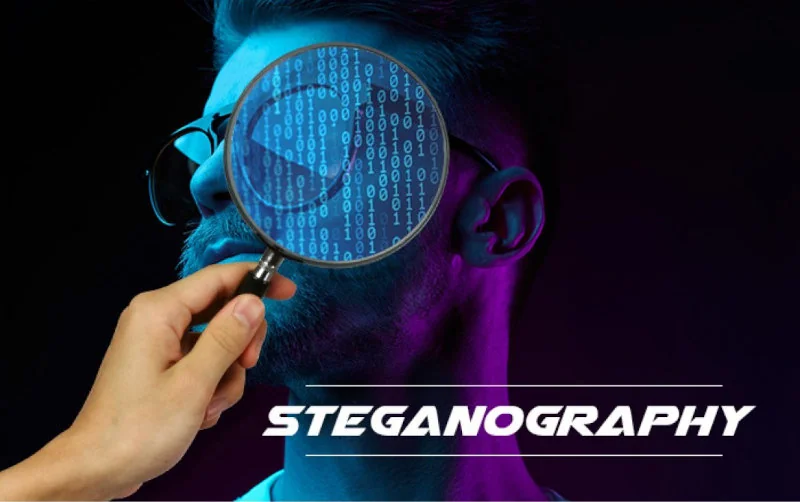Hiding in Plain Sight: A Beginner's Guide to Steganography
Published on

An image showing binary code overlaid on a magnifying glass
In our digital world, we are constantly surrounded by data. Every image we see, every song we hear, every website we visit is a complex collection of ones and zeros. To most of us, a picture of a cat is just a picture of a cat. But to a student of steganography, that same picture could be a vessel—a digital Trojan Horse carrying a hidden message, a secret password, or a covert plan.
Welcome to the art of hiding in plain sight.
While its cousin, cryptography, focuses on making messages unreadable with complex codes, steganography’s goal is far more subtle: to make a message invisible. It’s the practice of concealing a file, message, image, or video within another file, message, image, or video. The ultimate aim is to create a combined piece of data that is completely unremarkable, arousing no suspicion from prying eyes.
If you’ve ever played the Venatus challenge, you’ve already dipped your toes into this fascinating world. This guide will pull back the curtain and give you a beginner-friendly tour of the most common types of digital steganography you’ll encounter online and in our game.
Table of Contents
- 1. Text Steganography: The Art of the Invisible Word
- 2. Image Steganography: The Million-Pixel Canvas
- 3. Audio Steganography: Hiding Secrets in Sound
- 4. Network Steganography: The Ultimate in Stealth
- A World of Hidden Messages
- Frequently Asked Questions
- References
1. Text Steganography: The Art of the Invisible Word

Text-based steganography is one of the oldest and most clever forms of the art. It doesn’t rely on complex files, but on the very way we write and display text. The secret is often hidden in a way that is either grammatically or visually imperceptible.
Methods
*Semantic & Linguistic: This involves changing the words themselves to encode a message. For example, the second letter of every fifth word in a paragraph could spell out a secret. This is difficult to do well without sounding unnatural, but it’s a classic technique. *Visual Manipulation (CSS & HTML): This is a favorite trick on the web, and the one you encounter in Level 1 of our challenge. A secret message can be typed directly into a webpage but made invisible by:
* Setting its color to be the same as the background.
* Setting its font size to zero.
* Hiding it within HTML comments, which are ignored by the browser but visible in the page source.*Zero-Width Characters: As you discover in Level 6, the Unicode standard includes special characters that take up no space and are completely invisible in most text editors. By embedding these characters between the normal letters of a sentence, one can hide a significant amount of data in a seemingly innocent piece of text.
The beauty of text steganography lies in its simplicity. It often requires no special software to decode, only a curious mind and the willingness to look “under the hood” with a browser’s developer tools.
2. Image Steganography: The Million-Pixel Canvas

This is the most common and widely known form of digital steganography. Images are the perfect medium for hiding data because they are made of millions of individual data points (pixels), and the human eye is remarkably forgiving of tiny, insignificant changes.
Method: Least Significant Bit (LSB) Encoding
The king of image steganography is the Least Significant Bit (LSB) technique. Here’s how it works in simple terms:
- Pixels and Colors: Every pixel on your screen is defined by a color, typically represented by three values: Red, Green, and Blue (RGB). Each of these values is a number, usually from 0 to 255.
- The Binary World: In binary, the number 255 is
11111111. The number 150 is10010110. The very last bit on the right is the “least significant bit” because changing it has the smallest possible impact on the total value. For example, changing10010110(150) to10010111(151) results in a change in color so minuscule that the human eye cannot perceive it. - Hiding the Data: A steganographic program takes the secret message, converts it into a stream of bits (0s and 1s), and then systematically overwrites the LSB of the color values of each pixel in the image with the bits of the secret message.
The result is a new image that looks identical to the original but now contains a hidden payload. This is the exact technique you must overcome in challenges like Level 3.
Other methods include hiding data in a file’s metadata (as seen in Level 2), which isn’t technically in the image pixels but is a form of data concealment all the same.
3. Audio Steganography: Hiding Secrets in Sound

Just like images, audio files are vast collections of data points (sound samples), making them another excellent carrier for hidden information.
Audio Methods
*LSB Audio: This works on the same principle as image LSB. Each sound sample has a specific numerical value. By slightly altering the least significant bit of thousands of samples per second, a secret audio or text message can be embedded without any audible difference. *Echo Hiding: This technique hides data by introducing a tiny, almost imperceptible echo into the audio file. The delay and amplitude of the echo can be modulated to represent binary 0s and 1s. The human ear can’t distinguish this echo from natural reverb, but a computer program can detect it and reconstruct the message. *Spectrogram Hiding: This is one of the most visually fascinating methods, and the one used in Level 4. A spectrogram is a visual image of sound, showing frequencies over time. By embedding specific, high-frequency tones into an audio file, it’s possible to “draw” an image or text into the spectrogram. It might sound like strange noise to the ear, but when visualized, the secret message appears.
4. Network Steganography: The Ultimate in Stealth

This is arguably the most advanced and difficult-to-detect form of steganography, often used in sophisticated cyber-attacks and espionage. Instead of hiding data in a single file, it hides data in the very stream of network traffic flowing in and out of a computer.
Network Methods
*Protocol Abuse: Data can be hidden in the headers of common network packets (like TCP/IP) in fields that are often ignored or have variable lengths. *Covert Channels: An attacker can use an unusual protocol for communication. For example, the ICMP protocol, normally used for simple “ping” requests to see if a server is online, can be used to carry small amounts of data back and forth. Since many systems don’t heavily scrutinize ping traffic, it can be an effective way to exfiltrate data, as you’ll discover in Level 9. *Timing Channels: This highly advanced method encodes data not in what is sent, but when it is sent. For example, waiting 100 milliseconds between packets could represent a “0”, while waiting 200 milliseconds could represent a “1”. This is incredibly difficult to detect as it looks just like normal network lag.
A World of Hidden Messages
From a simple colored word on a webpage to a complex pattern of network requests, steganography is all around us. It is a tool that can be used for good—by journalists and activists in repressive regimes to communicate safely—or for ill, by malware to steal information.
By playing games like Venatus, you are not just solving puzzles; you are learning the language of this hidden world. You are training your mind to look past the obvious and to ask the most important question a digital detective can ask: “What am I not seeing?”
Frequently Asked Questions
What is the difference between steganography and cryptography?
Steganography hides the existence of a message within another medium, like an image or audio file, so it appears unremarkable. Cryptography scrambles a message to make it unreadable without a key, but the message’s existence is still visible.
Why are images commonly used for steganography?
Images are ideal due to their large data capacity (millions of pixels with RGB values), the human eye’s inability to detect minor changes (e.g., in LSB encoding), and multiple hiding spots like metadata or pixel data.
Can steganography be used with any file type?
Yes, steganography can be applied to many file types, including text, images, audio, video, and network traffic, as long as there’s enough data capacity and a method to embed information without noticeable changes.
How secure is steganography for hiding messages?
Basic steganography, like LSB, can be detected by steganalysis tools that identify statistical anomalies. Combining steganography with encryption and using advanced techniques improves security.
What tools can beginners use to experiment with steganography?
Beginners can use tools like Steghide (for images), DeepSound (for audio), or simple Python scripts with libraries like Pillow to hide and reveal messages, as seen in the Venatus challenges.
References
Image Steganography & LSB Techniques
-
Alsaadi, A. M. (2022). Image Steganography using Least Significant Bit (LSB) - A Systematic Literature Review. ResearchGate. https://www.researchgate.net/publication/358680915_Image_Steganography_using_Least_Significant_Bit_LSB_-_A_Systematic_Literature_Review
-
Banerjee, I., Bhattacharyya, S., & Sanyal, G. (2017). Novel LSB based image steganography technique with enhanced security. IEEE Xplore. https://ieeexplore.ieee.org/document/4221886/
-
Ghebleh, M., & Kanso, A. (2013). An enhanced Least Significant Bit steganography method using midpoint circle approach. IEEE Conference Publications. https://ieeexplore.ieee.org/document/6949808/
-
Kanan, H. R., & Nazeri, B. (2022). Image Steganography using Least Significant Bit (LSB) - A Systematic Literature Review. IEEE Xplore. https://ieeexplore.ieee.org/document/9711628/
-
Mishra, M., Tiwari, P., & Mishra, A. (2023). Steganography on Color Images Using Least Significant Bit (LSB) Method. Atlantis Press. https://www.atlantis-press.com/proceedings/iconnsmal-22/125987138
-
Mustafa, W. A., & Khudhur, A. A. (2023). Image Steganography Using LSB and Hybrid Encryption Algorithms. MDPI Applied Sciences. https://www.mdpi.com/2076-3417/13/21/11771
-
Ni, Z., Shi, Y. Q., Ansari, N., & Su, W. (2024). A novel and efficient digital image steganography technique using least significant bit substitution. Scientific Reports. https://www.nature.com/articles/s41598-024-83147-3
-
Rashid, A. (2019). Image Steganography and Steganalysis Based on Least Significant Bit (LSB). ResearchGate. https://www.researchgate.net/publication/335996768_Image_Steganography_and_Steganalysis_Based_on_Least_Significant_Bit_LSB
Audio Steganography & Echo Hiding
9.Cvejic, N., & Seppänen, T. (2012). Comparative study of digital audio steganography techniques. EURASIP Journal on Audio, Speech, and Music Processing. https://asmp-eurasipjournals.springeropen.com/articles/10.1186/1687-4722-2012-25
10.Fallahpour, M., & Megias, D. (2021). Presenting a Method for Improving Echo Hiding. ResearchGate. https://www.researchgate.net/publication/349335429_Presenting_a_Method_for_Improving_Echo_Hiding
11.Ktekeli, et al. (2017). A Comparison of Echo Hiding Methods. ResearchGate. https://www.researchgate.net/publication/326720071_A_COMPARISON_OF_ECHO_HIDING_METHODS
12.Ruppert, S. (2024). Audio Steganography In More Detail. Personal Blog. https://svenruppert.com/2024/04/17/audio-steganography-in-more-detail/
13.Solusipse. Basic methods of Audio Steganography (spectrograms). Technical Blog. https://solusipse.net/blog/post/basic-methods-of-audio-steganography-spectrograms/
14.Taha, A., et al. (2024). A robust audio steganography technique based on image encryption using different chaotic maps. Scientific Reports. https://www.nature.com/articles/s41598-024-70940-3
Network Steganography & Covert Channels
15.Ahsan, K., & Kundur, D. (2008). Implementation of an ICMP-based covert channel for file and message transfer. ResearchGate. https://www.researchgate.net/publication/224349250_Implementation_of_an_ICMP-based_covert_channel_for_file_and_message_transfer
16.Cynet. (2025). How Hackers Use ICMP Tunneling to Own Your Network. Cynet Security Blog. https://www.cynet.com/attack-techniques-hands-on/how-hackers-use-icmp-tunneling-to-own-your-network/
17.Mazurczyk, W., & Szczypiorski, K. (2011). PadSteg: Introducing Inter-Protocol Steganography. arXiv. https://arxiv.org/pdf/1104.0422
18.ScienceDirect. Covert Channel - An Overview. ScienceDirect Topics. https://www.sciencedirect.com/topics/computer-science/covert-channel
19.Tian, H., et al. (2020). A Survey of Key Technologies for Constructing Network Covert Channel. Security and Communication Networks. https://onlinelibrary.wiley.com/doi/10.1155/2020/8892896
Additional Resources
20.Arora, S. K. (2018). Audio Steganography: The art of hiding secrets within earshot (part 2 of 2). Medium. https://sumit-arora.medium.com/audio-steganography-the-art-of-hiding-secrets-within-earshot-part-2-of-2-c76b1be719b3
21.RenanTKN. (2021). LSB Steganography — Hiding a message in the pixels of an image. Medium. https://medium.com/@renantkn/lsb-steganography-hiding-a-message-in-the-pixels-of-an-image-4722a8567046
22.Smendowski. Hidden Communication Using Covert Channels. GitHub Repository. https://github.com/Smendowski/hidden-communication-using-covert-channels
23.Wendzel, S. The Covert Channel Educational Analysis Protocol (CCEAP). GitHub Repository. https://github.com/cdpxe/CCEAP